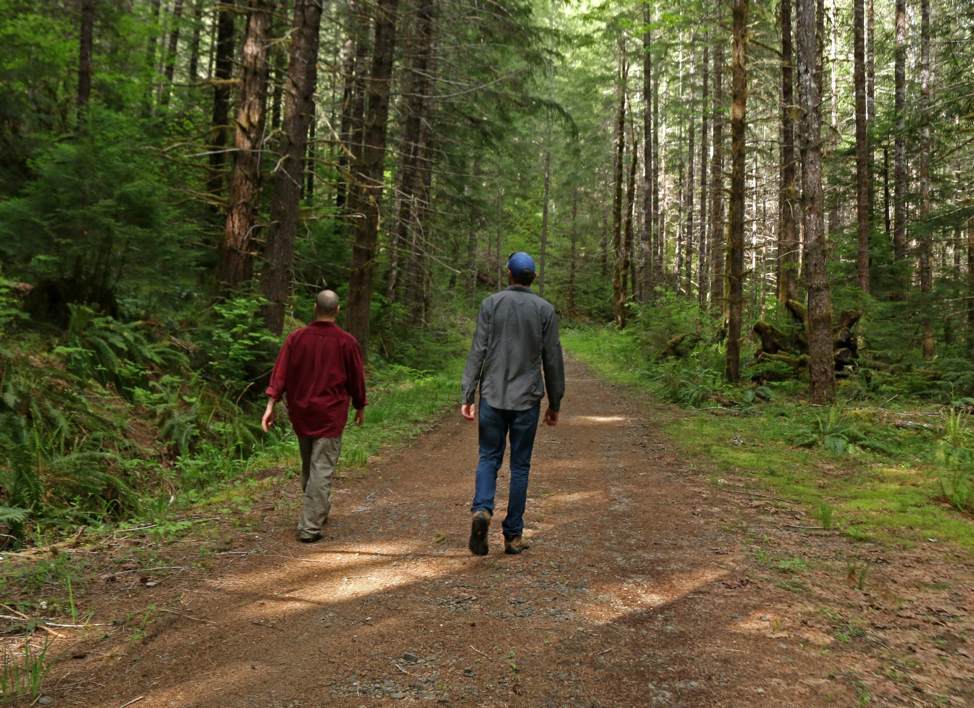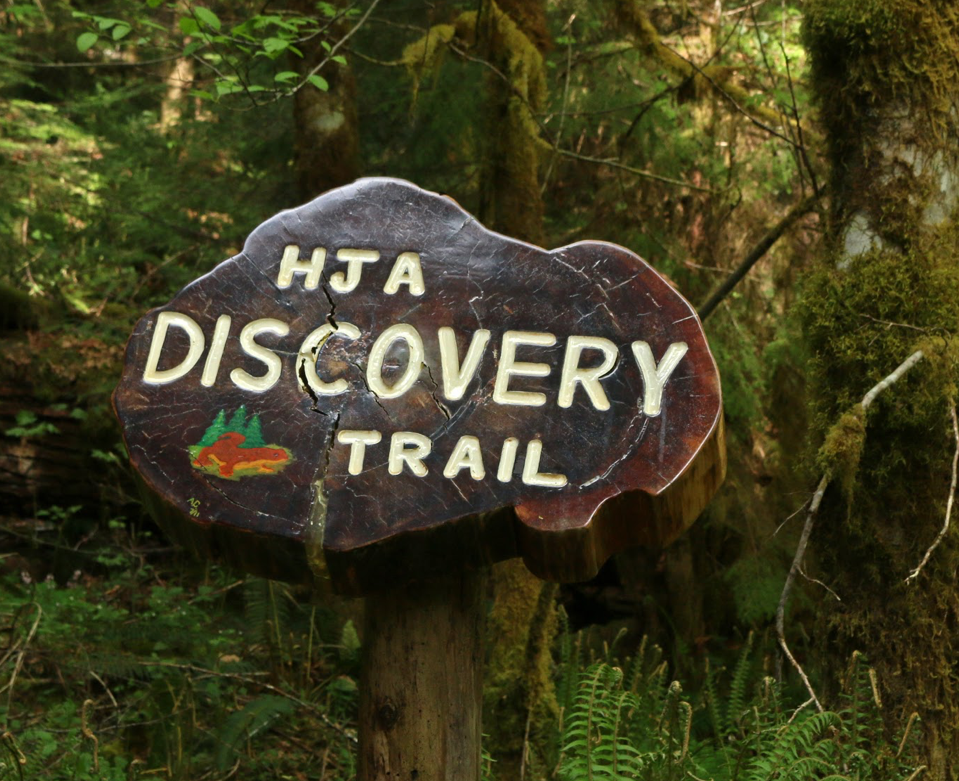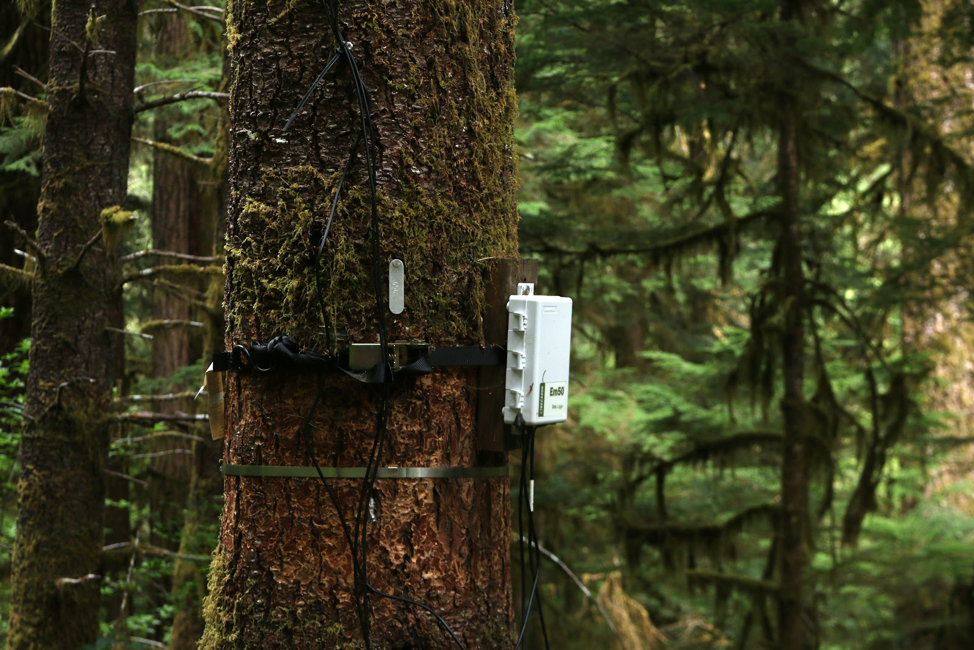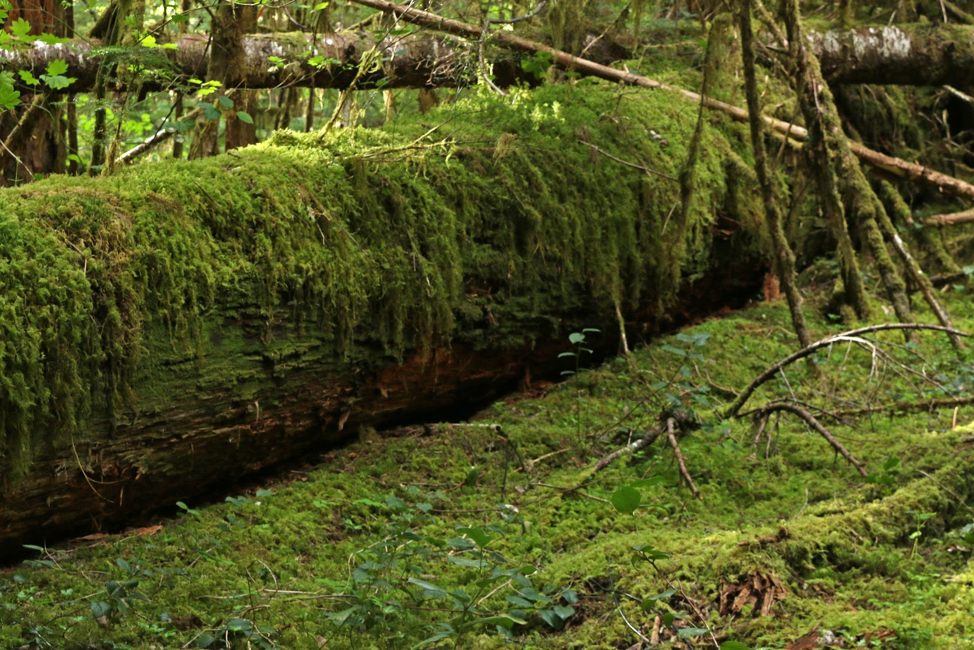
Looking up at the Douglas Fir canopy in Andrews Forest.
Credit: E Zambello/LTER-NCO CC BY 4.0
Past the Blue River Reservoir I drove, stopping to admire the reflection of Oregon puffy clouds in the calm water, rimmed by deep emerald mountains and home to a small family of Canada geese, an osprey, a common merganser, and a busy spotted sandpiper complete with a rapidly bobbing tail.
Just up the hill from the reservoir, above a public camping area, sits the HJ Andrews Experimental Forest Long Term Ecological Research (LTER) Site headquarters, adjacent to the swiftly flowing Look-out Creek. Cool air enveloped me as I jettisoned myself from the car, flanked by tall peaks on both sides, Douglas Fir trees appearing absolutely enormous.
The Campus
The campus buildings huddle together, painted brown to blend in to their surroundings. A general office provides space for students and researchers to work, a computer room with a faster internet connection providing a connection to an outside world that suddenly felt much farther away. A library and small front office for visitors to check in completed the space, and I walked down a hallway, searching for Mark Schulze, Forest Director.
Schulze has lived here for years in a beautiful home reserved for staff and visiting artists, located at the end of the building cluster. Long pants, boots, and a light jacket with the sleeves rolled up established the general uniform of his profession: forest ecologist. He showed me to my mini-apartment, between two others in the “Rainbow” building, across from the cafeteria and two other dorm-like buildings. I loved the space instantly, from the old chairs on the wide wooden porch to the small kitchen, living room, and double bed with a window facing a grassy lawn and the dense forest beyond. I could have stayed for weeks.

Walking along a dirt road through Andrews Forest.
Credit: E Zambello/LTER-NCO CC BY 4.0
I arrived around 4 p.m., and already the light waned. After quickly unloading a few bags and groceries, I followed Schulze down the short campus road and into the forest itself.
Named the official state tree in the 1930’s, the Douglas Fir plays a critical role in Oregon’s ecology. The trees can grow from sea level all the way up to 5,000 feet, and are known for a wide variety of wood products, including boards, timber beams, veneer, and paper.
The spicy smell of pine and wet ground enveloped us in a chilly embrace. Narrower trees stood completely covered in bright green moss, the same moss that grew over the surface of downed logs and bare ground. Tiny, delicate wildflowers provided pops of white, purple, yellow, and pink against the varied greens of the woods, while the clustered, pale blooms of dogwood trees drew the eye as they contrasted with evening shadows. Every few yards we would stop, and I held the back of my neck to stare up the thick, ribbed bark of the tallest and widest fir trees.
Exploring the Discovery Trail

The Andrews Discovery Trail trail entrance.
Credit: E Zambello/LTER-NCO CC BY 4.0
Before darkness completely descended I yearned to see the Discovery Trail and Discovery Tree. The Discovery Trail, complete with polished, wooden sign posts corresponding to a digital lesson plan, was designed for school groups from the surrounding area who journeyed here to learn about forest ecosystems. The trail is narrow, weaving through giant old growth Douglas Fir as well as shorter, second growth trees. The Discovery Tree itself stands just off the path, growing here for over 400 years.
Unlike most trees at Andrews, this one is totally wired. First installed in 2014, infrared cameras collect surface temperature data on both old and second growth forest tracts; real-time data is also collected on temperature, leaf wetness, relative humidity, soil temperature, soil moisture, wind direction and speed. As the Andrews’ website explains: “This suite of data serves as a glimpse into the canopy and soil processes we are unaware of when our feet are planted firmly on the ground.”

A wired tree.
Credit: E Zambello/LTER-NCO CC BY 4.0
Nearby, a smaller, second growth tree is in the process of being similarly outfitted with sensors and equipment. I chided Schulze when we started the short hike because the new tree remained nameless, lacking a suitable title to go along with “The Discovery Tree.” Could I think of one? No. I am equally terrible at puns and jokes, but Schulze suddenly had a flash of inspiration: “Groot!”
Groot, the tree-alien creature made famous by the Guardians of the Galaxy movie franchise, is reborn in the film, thus a well-suited symbol for a second-growth tree. The name is utterly perfect, and I told practically everyone I met at Andrews about the possible new name.
The two trees, complete with their sensors along different canopy levels, give researchers at Andrews at glimpse at the varying micro-climates within Douglas Fir forests, including the differences between old and new growth forests. Additionally, the real-time data collected by the team can be used by other scientists, as well as K-12 and college students to give them a better understand of forest dynamics from a tree they have seen with their very own eyes.

A fir tree decomposes on the ground.
Credit: E Zambello/LTER-NCO CC BY 4.0










